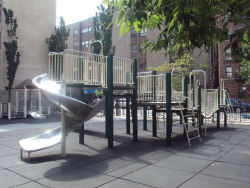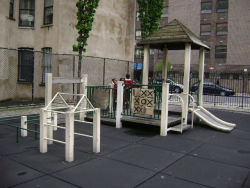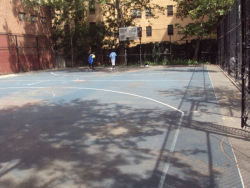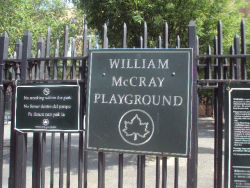William McCray Playground
William McCray Playground
What was here before?
Originally home to the Lenape, this site was on the border of verdant marshland. In 1639, the Dutch West India Company deeded the area that would become Harlem to Dutch merchant Jochem Pieter. By the 19th century, this property was along the farmland properties owned by Peter Myer Jr. and John Delancey.
St. Mark the Evangelist Church opened at this site in 1912. The Catholic church and school were the first in the city to welcome Black congregants.
How did this site become a playground?
The City purchased the property from the church in 1934 to build a playground. It is one of nine playgrounds built by the Parks Department through a war memorial fund. With additional funding from the Federal Temporary Emergency Relief Administration, the nine playgrounds were constructed within four months. The playgrounds were dedicated simultaneously on July 15, 1934, in a ceremony led by Mayor Fiorello H. LaGuardia and Parks Commissioner Robert Moses at William E. Sheridan Playground in Brooklyn. An elaborate public address system broadcast the ceremony from Brooklyn to all the other playgrounds.
Each site was equipped with a play area, wading pool, brick fieldhouse, and flagpole. Marked with a commemorative tablet, each property honors the memory of a soldier who died in combat. This site was named after William McCray, a soldier with the Harlem Hellfighters.
Adjoining lots were added in 1989 and 1992, more than doubling the size of the property. The playground was renovated in 1994, and in 2024 it was redesigned with new play equipment, seating, game tables, picnic area, spray shower, plantings, and a basketball court. Three entrances to the park were consolidated into one inviting entryway that leads to a central plaza and synthetic turf lawn which serve as an outdoor classroom, exercise area, and play space. The new park design pays subtle homage to William McCray’s military service, including a chevron paving pattern and a sinuous concrete design at the spray shower, an abstraction of the coiled rattlesnake on a patch of the Hellfighters’ uniform.
Who is this playground named for?
World War I soldier William McCray (1898-1918) was born in New York City in 1898. He attended public school locally and enlisted on June 4, 1917, in the 15th Infantry Regiment, New York National Guard, the troop popularly known as the Harlem Hellfighters. The enlisted men in the regiment (formed in 1913) were African American, while most of the officers were white. The soldiers arrived in France in December 1917 and were redesignated as the 369th Regiment. They joined the 16th and 161st Divisions of the French Army under the command of General Henri Gouraud (1867-1946). Using French weapons, helmets, and equipment, the 369th fought bravely and earned the Croix de Guerre military decoration as a unit citation. When the American headquarters asked the French to segregate the troops, the request was refused. The Harlem Hellfighters fought for 191 days in continuous combat, which is believed to be more time than any other American unit.
McCray was killed in a local infantry attack in the Champagne Sector on September 12, 1918, attaining the rank of corporal before his death.
Check out your park's Vital Signs
Clean & Safe
Green & Resilient
Empowered & Engaged Users
Share your feedback or learn more about how this park is part of a
Vital Park System




